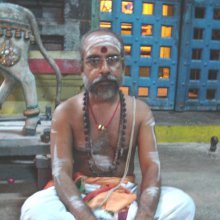Tiruchendur, Tirucendur, Tirucentur: 1 definition
Introduction:
Tiruchendur means something in the history of ancient India. If you want to know the exact meaning, history, etymology or English translation of this term then check out the descriptions on this page. Add your comment or reference to a book if you want to contribute to this summary article.
Images (photo gallery)
India history and geography
Source: Shodhganga: The significance of the mūla-beras (history)Tiruchendur (also spelled Tirucendur/Tirucentur) is one of the six abodes of Murugan in Tamilnadu, and where is located the Subramanya Swamy Temple (or Subrahmaṇya Svāmi Temple), representing a sacred place for the worship of Murugan.—Tiruchendur is the second of the six sacred abodes dedicated to Lord Murukan (Murugan). It is a famous Murukan-sthala, situated on the sea shore in Tirunelveli District. Some of the other names of this sthala are Sentil, Ālaivai, Tirusentil, Tirucīrālavai, Tirusentilūr, Jayanthipuram, Śrī Sānti Nagar and Sandanacalam. Murukan is also known by the name of Cen Ten; the place where he dwells is Centuil which later became Sentil, Sentilūr, Sentūr and Centūr.
Tiruchendur according to the Sthala-purāṇa, “[...] Seeing the pitiable state of the devas, Śiva created six flames from his third eye. The six flames came from Satjota, Vāmadeva, Tatpuruṣa, Īsāna, Agora, and Jammuka Śiva, the different forms of Śiva. Śiva told the Vāyudeva and the Agnideva to let the six flames in the Gaṅga. The Gaṅga carried the flames and let them in the Saravana Poigai. The six flames turned into six children and they started crawling in six lotuses. The Kārtikai girls fed the six children. Goddess Pārvatī took the six children and made them into one body with six faces and named him Kanda. At the request of the Devas, Goddess Pārvatī gave the child her weapon, the vel (spear) and sent him to kill Sūrapadma. Murukan went with his army and settled in Tiruchentur where he fought against Sūrapadma”.
Source: Shodhganga: Siddha Cult in TamilnaduTiruchendur refers to one of the various famous Siddha Centre distributed throughout South India and Tamil Nadu. The Siddha cult represents a Tantric philosophy that emerged from the combination of several elements found in traditions such as Shaivism (viz., Pashupata), Shaktism, Jainism, Tantric Buddhism (Vajrayana), etc. Both the Siddha and the Navanath cult (i.e., Nava-natha, ‘nine saints’) are popular in South India [viz., Tiruchendur] and Tamilnadu. A Siddha was an inspired seer belonging to the marginalized sections of society who dissolved their past karma and crushed the roots of future karma.

The history of India traces the identification of countries, villages, towns and other regions of India, as well as mythology, zoology, royal dynasties, rulers, tribes, local festivities and traditions and regional languages. Ancient India enjoyed religious freedom and encourages the path of Dharma, a concept common to Buddhism, Hinduism, and Jainism.
See also (Relevant definitions)
Full-text: Shanishvar, Candikeshvar, Venkatacalapati, Surasamhara, Mayuranatha, Balasubrahmaṇya, Kayalpattanam, Subramanya-swamy, Shanmukha, Angamangalam, Bhairava, Vinayaka, Skandashashthi, Thiruparankundram, Murugan.
Relevant text
Search found 3 books and stories containing Tiruchendur, Tirucendur, Tirucentur; (plurals include: Tiruchendurs, Tirucendurs, Tirucenturs). You can also click to the full overview containing English textual excerpts. Below are direct links for the most relevant articles:
Temples of Munnur (Historical Study) (by R. Muthuraman)
Images of Subramanya < [Chapter 5]
Pallava period (Social and Cultural History) (by S. Krishnamurthy)
Origin of Sculptural Art (b): Pre-Pallava Period < [Chapter 2 - Origin of Sculptural Art—Its Development and Scheme]
Socio-Religious Life of the Pre-Pallava Period < [Chapter 3 - Socio-Religious Life]
Reviews < [October – December, 1999]
